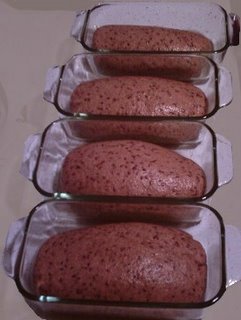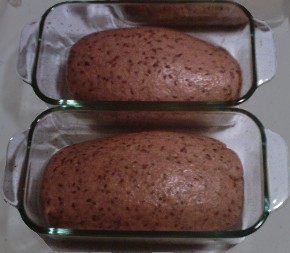Sourdough Starters will take over your life, if you let them.
So, I was looking through Sourdough Home about the proper care and maintenance of sourdough starters, because I’ve been wondering about mine. I’ve been keeping them rather stiff – more like a dough than a slurry – and was wondering, ’cause they seem to work quite well like that. I’d seen somebody on one of Julia Child’s shows do that and call it a levain, so it seemed right to me to maintain them like that (one white, the other whole wheat, as Alton suggests). Well, Sourdough Home agrees that it’s OK to do that, but gave me some new information about the refreshing process, so that you get the proper rise out of them.
Long and short, we ended up taking my starters from their jars & radically growing them, so that they wouldn’t smell sour any more, and so that they’d be a bit healthier. Out of all this? 16 pizza crusts, pre-baked & dropped in the deep-freeze, and 4 loaves of broccoli-cheese-onion bread. Oh – and a couple of very happy starters.

Other than the starters, this weekend involved making and canning 9 quarts of mincemeat (mango / pineapple / ginger) and 14 half-pints of chutney (mango / onion / chocolate habañero). We haven’t given any away yet … and it’s going to be a hard, hard decision as to who gets the chutney! Last year’s chutney we weren’t too hot on, ’cause it really wasn’t a finished sauce so much as it was a marinade. This year’s is definitely a finished sauce, and has just the right balance of hot / sweet because of the chocolate habañero (yes – just one single pepper for the whole bunch). I believe that we may be saving these things up for the next Brunch (you know who you are, people) … but there’s been some who have made other plans during this holiday season.
To get your tastebuds appropriately interested in Chutney, I’ve been told to include a recipe which might get you salivating enough to participate in social events (and, maybe, if you’re lucky, receive some chutney):
Flaxseed Falafel with Tzatziki
16 pieces/serves 8
Flaxseed, ground for the batter, and left whole for the coating, give this adaptation of a recipe from Johnson & Wales University in Charlotte, N.C., distinct flavor and texture.
The tzatziki:
- 1 cup cucumber, peeled, seeded, diced into ¼-inch cubes
- 1½ teaspoons kosher salt
- 1 cup low-fat plain yogurt
- 1 cup regular or reduced-fat sour cream
- ½ teaspoon sugar
- 2 cloves garlic, minced
- 1-1½ tablespoons chopped fresh dill
The falafel:
- 2 cans garbanzos, drained, liquid reserved
- 1 clove garlic, crushed
- 1/2 cup ground flaxseed
- 1/2 cup chopped parsley
- 1/4 cup fresh-squeezed lemon juice
- 1/2-3/4 teaspoon salt + more to taste
- 1/2 teaspoon ground coriander seed
- 1/2 teaspoon cayenne pepper
- 3/4 cup dry bread crumbs
- 3 tablespoons whole flaxseed
- 1 egg white
- 2 tablespoons water
- Cooking spray as needed
- 2 tablespoons olive oil
To prepare the tzatziki: Mix diced cucumber with salt, place in a colander set over a bowl; cover with plastic wrap and refrigerate for one hour. Rinse off the salt, drain well and dry cucumber on several thicknesses of paper towels. In a bowl, combine cucumber with yogurt, sour cream, sugar, garlic and dill. Cover and chill at least 30 minutes and up to four hours.
To prepare the falafel: Place garbanzos, garlic and 2 tablespoons reserved garbanzo liquid in a processor and pulse about 5 times, until coarsely chopped. Add ground flax seed, parsley, lemon juice, salt, coriander and pepper and pulse just until mixture is combined. It should retain some texture. Divide into 16 portions and shape into patties about 1½ inches in diameter. Combine bread crumbs and whole flax seed in a shallow dish.
In another shallow dish, combine egg white and water. Dip each patty in the egg white, then lightly dredge in crumb mixture. Set on a rack over a baking sheet to dry for half an hour. Heat a large nonstick skillet over medium-high heat and add oil. Brown falafel well on both sides, turning once.
Serve with tzatziki.
Per serving: 300 calories, 11 g protein, 33 g carbohydrate, 15 g fat (5 g saturated), 15 mg cholesterol, 497 mg sodium, 11 g fiber.
Instead of the tzatziki, it could go with chutney easily!




 actually funny. But, never fear, we who Wish We Were Baking will always find a way… and a means… and a little bit of dough…
actually funny. But, never fear, we who Wish We Were Baking will always find a way… and a means… and a little bit of dough…


 It’s a quick and easy soup that goes really well with… um… well, bread. Whole wheat rolls, in fact. Or foccacia bread, topped with savories. (Sorry, I haven’t yet figured out what doesn’t go with bread.) Anyway, rye in soup is great, because, unlike barley, it doesn’t suck up all the liquid in the universe. The soup isn’t as velvety, but that’s just fine too.
It’s a quick and easy soup that goes really well with… um… well, bread. Whole wheat rolls, in fact. Or foccacia bread, topped with savories. (Sorry, I haven’t yet figured out what doesn’t go with bread.) Anyway, rye in soup is great, because, unlike barley, it doesn’t suck up all the liquid in the universe. The soup isn’t as velvety, but that’s just fine too.